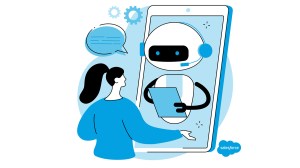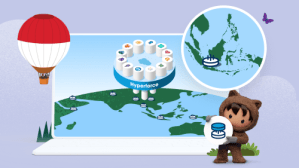Is Customer Loyalty the New Currency?



Customer loyalty is a driving force behind business success. Learn why CEOs should care about it, and how to foster customer loyalty.

Leandro Perez
Recently, I sat down with Neeracha Taychakhoonavudh, Executive Vice President, Global Customer Success and Strategy. We talked about why customer loyalty is now worth its weight in gold. These are just some of my takeaways from that conversation, along with some quotes from Neeracha that I think get to the heart of the issue.
In early 2020, the way the world conducted business underwent a sudden yet necessary transformation that placed digital technologies at the centre of everything. Now, a little over two years later, the move to digital continues to accelerate, with both companies and customers operating primarily in online environments.
Understandably, such a seismic operational shift has led to radically changed mindsets and behaviours on a human level. Customer expectations are still evolving and increasing in complexity. Organisations are racing to meet them as simply and effectively as possible. For CEOs, doing so requires putting the customer first and catering to their demands for new levels of personalisation.
“Everyone wants to go digital faster than ever” Neeracha told me. “They expect results now, or really, yesterday. And they’re thinking about things in a much more agile and flexible manner”.
Because digital has bred this kind of customer-centricity, Neeracha says that “customer loyalty is the new currency.” What this means is that because consumers now have more options, securing customer trust in your brand is considerably harder. Therefore, customer trust holds more value than ever before.

It’s easier to retain an existing customer than attract a new one
With businesses of all sizes worldwide attempting to operate via multiple platforms and channels, it’s understandable that the market is oversaturated. Companies now have access to a wide variety of ways to compete for the attention of consumers. Consumers can now choose brands based on unique preferences, tastes, and values. In this noisy environment, it can be difficult to attract new customers.
That is why it is not only easier to retain existing customers, but as Neeracha puts it, it’s “cheaper to do so”. Customer loyalty is built upon existing relationships. If you leverage that brand recognition, adopt the right tools and work with the right data in the right ways, you can deliver exactly what the customer wants in 2022 and beyond.
The rise of the subscription-based model
One such way of securing brand loyalty is through subscription services.
These services are gaining popularity across many industries including retail, consumer goods, media, and publishing. Consumers will stick with a company that gives them what they need, but they also want to feel a sense of personal connection to a brand.
Giving customers a reason to ‘opt in’ is fast becoming an imperative for businesses of all sizes. This is because a subscription-based model can help create and develop those close bonds with the individual customer.
As Neeracha said in our conversation, “companies actually want that direct customer connection, even if they are operating in traditional distribution channels”.
A prime example of a subscription service is the loyalty program, which can be used to provide premium experiences to existing customers. Such programs come in different forms, both free and paid, including those based on purchase history. Through the proper use of data, these programs can be hyper-targeted to a customer’s moment-to-moment needs.
A 2020 McKinsey survey revealed that members of paid loyalty programs are 60% more likely to continue purchasing from a brand. These paid (and often points-based) programs are rising in popularity due to the exclusive benefits to the customer. These can include discounted offers and unique content.
At the same time, free subscription services such as newsletters should not be underestimated. These can provide personalised recommendations and communications that also foster customer loyalty.
Neeracha drew on personal experience to get to the heart of the power of these services – “As a consumer, I want my favourite businesses to survive and thrive. I’m a subscriber to my favourite restaurant and that’s forging a far deeper relationship between us.”
Why is customer loyalty a CEO-level mandate?
Prior to the pandemic, digital operations were often siloed or relegated to individual departments such as IT. Since then, these operations have blossomed into an organisational priority – from the CEO down. Those at the top now see that digital is not only here to stay. They understand that harnessing digital and data in meaningful ways leads to an endless list of benefits, including increased customer loyalty.
One of the primary reasons CEOs are seeing the link between digital technologies and customer loyalty is the speed with which that loyalty can grow. When everything was mostly face to face, relationships took time to build and nurture. Now, organisations can use sophisticated tools to grab a customer’s attention from anywhere, at any time, from a multitude of touchpoints.
Neeracha has witnessed this change first-hand. The Chief Digital Officer (CDO) of a Salesforce customer in the Netherlands reported that their CEO was not only prioritising digital, but promoting further acceleration: “In just a few weeks, they had been able to accomplish more than they had in the previous three years. So much so that the CEO was actually calling and asking: can they push the tech further? Can they set it up even faster?”
This is the way of the new world. CEOs are seeing the effects that digital acceleration has on customer retention, and are actively digging deeper into the tools that enable it.
The power of data
The tools that enable this speedier (and richer) customer loyalty rely almost exclusively on data. Customer Relationship Management (CRM) software and related technology platforms afford organisations new ways of seeing and understanding consumers. By collecting, integrating, and acting on the insights gained from a 360-degree view of the individual customer, companies can now offer unprecedented depth of personalisation.
Personalisation is the lifeblood of customer loyalty. Consumers want to feel that they are seen and heard, and not just another entry in a spreadsheet. They want to be given what they want, when they want it. Just as much as they don’t want to be on the receiving end of impersonal communications or irrelevant offers.
“The whole idea is that you are able to understand your customers much, much better,” says Neeracha. “Then you can engage in the appropriate way.”
Using the right tools to harness data allows organisations to engage in the right way. That is, eliminating what detracts customers and building upon what retains their loyalty.
The right tools
New heights of customer loyalty can be reached through Salesforce digital technologies such as Customer 360, which is the world’s leading CRM platform.
For every phase of the consumer journey, Customer 360 offers a best-in-class application. The more you build your CRM, the more you connect applications and integrate data, the closer you can get to the individual customer.
The closer you get to the individual customer, the stronger the loyalty. Considering that customer loyalty is the new currency, then Customer 360 is the best place to get it.
Read the Connected Shoppers Report to see how experiences and engagement underpin the future of loyalty. Also, take a look at the Digital Trends Report to discover current trends driving customer experiences.






















